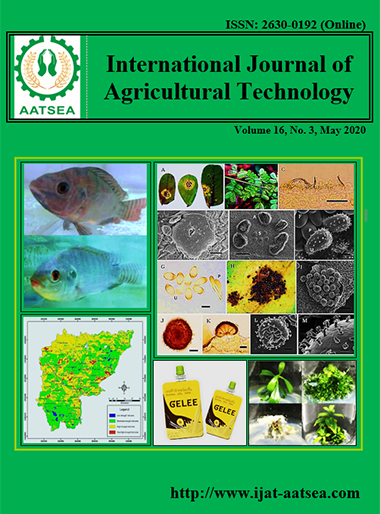Body darkening as thermal stress indicator for Nile tilapia (Oreochromis niloticus L.)
Main Article Content
Abstract
Increasing water temperature due to global warming has decreased the aquaculture production of tilapia in the Philippines. Stress is the initial effect of increasing temperature, but when stress prolongs and not predicted nor prevented, fish health is suppressed and may lead to mortality. Thus, stress indication is of premium importance. In order to provide a more convenient and reliable stress indication, this study had reported a morphological response parameter (body darkening) as a thermal stress indicator and used other established parameters to determine their associations and reliability. Results suggested that body darkening and all other stress indictors were positively and significantly related to water temperature. Particularly, 80.50% of the variations in body darkening scores were brought by the changes in water temperature. More so, body darkening revealed highly significant positive relationships with the darkening of the eye (ρ = 0.902, p <0.000, n =22), ventilation rates (ρ = 0.902, p <0.001, n =22), and cortisol levels (ρ = 0.868, p <0.001, n =22). Similar to other known stress indicators for fish, body darkening is likewise a realible, convenient, sensitive, and a non-invasive stress indicator.
Article Details

This work is licensed under a Creative Commons Attribution-NonCommercial-NoDerivatives 4.0 International License.
References
Alvarenga, C. M. D. and Volpato, G. L. (1995). Agonistic profile and metabolism in alevins of the Nile tilapia. Physiology and Behavior, 57:75-80.
Barreto, R. E. and Volpato, G. L. (2011). Ventilation rates indicate stress-coping styles in Nile tilapia. Journal Biosciences, 36:1-5.
Barton, B. A. (2002). Stress in fishes: a diversity of responses with particular reference to changes in circulating corticosteroids. Integrative and Comparative Biology, 42:517-525.
Barton, B. A. and Iwama, G. K. (1991). Physiological changes in fish from stress in aquaculture with emphasis on the response and effects of corticosteroids. Annual Review of Fish Diseases, 1:3-26.
Bell, A. M., Henderson, L. and Huntingford, F. A. (2010). Behavioral and respiratory responses to stressors in multiple populations of three-spined sticklebacks that differ in predation pressure. Journal of Comparative Physiology B (Biochemical, Systems, and Environmental Physiology), 180:211-220.
Bureau of Fisheries and Aquatic Resources (2019). The Philippine fisheries profile 2018. Preliminary copy. Retrieved from http://www.bfar.da.gov.ph.
Dela Cruz, M. B. (2018). Theremal stress responses of Nile tilapia under mesohaline condition. (Master’s Thesis). Central Luzon State University, Philippines.
Frietas, R. H. A., Negraob, C. A., Feliciob, A. C. and Volpato, G. L. (2014). Eye darkening as a reliable, easy and inexpensive indicator of stress in fish. Journal of Zoology, 117:179-184.
Gibson, A. K. and Mathis, A. (2006). Opercular beat rate for rainbow darters Etheostoma caeruleum exposed to chemical stimuli from conspecific and heterospecific. Journal of Fish Biology, 69:224-232.
Guerrero, R. D. (2019). Farmed tilapia production in the Philippines is declining: what has happened and what can be done. Philippine Journal of Science, 148:11-14.
Harper, C. and Wolf, J. C. (2009). Morphologic effects of the stress response in fish. ILAR Journal, 50:387-396.
Höglund, E., Balm, P. H. and Winberg, S. (2000). Skin darkening, a potential social signal in subordinate arctic charr (Salvelinus alpinus): the regulatory role of brain monoamines and pro-opiomelanocortin-derived peptides. Journal of Experimental Biology, 203:1711-21.
Mommsen, T. P., Vijayan, M. M. and Moon, T. W. (1999). Cortisol in teleosts: dynamics, mechanisms of action, and metabolic regulation. Review of Fish Biology and Fisheries, 9:211-268.
Odore, R., D’Angelo, A., Badino, P., Bellino, C., Pagliasso, S. and Re, G. (2004). Road transportation effects blood hormones levels and lymphocyte glucorticoid and B-adrenergic receptor concentrations in calves. Veterinary Journal, 168:297-303.
Rani, S. (2016). Effect of water temperature on respiratory rate of fish, Cirrhinus mrigala. Indian Journal of Fundamental and Applied Life Sciences, 6:13-15.
Szisch, V., Van Der Salm, A. L., Wendelaar Bonga, S. E. M. and Pavlidis, M. (2002). Physiological colour changes in the red porgy, Pagrus pagrus, following adaptation to blue lighting spectrum. Fish Physiology and Biochemistry, 27:1-8.
Van Ham, E. H., Anholt, R. D. V., Kruitwagen, G., Imsland, A. K., Foss, A., Sveinsbo, B. O., Fitzgerald, R., Parpoura, A. C., Stefansson, S. O. and Bonga, S. E. W. (2003). Environment affects stress in exercised turbot. Comparative Biochemistry and Physiology, 136:525-538.
Volpato, G. L., Luchiari, A. C., Duarte, C. R. A., Barreto, R. A. and Ramanzini, G. C. (2003). Eye color as an indicator of social rank in the fish Nile tilapia. Brazilian Journal of Medical and Biological Research, 36:1659-1663.


